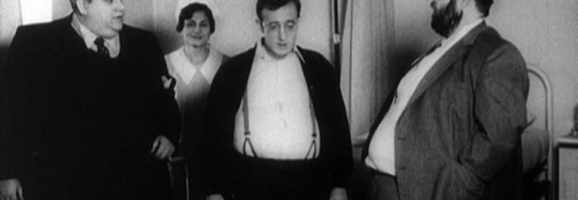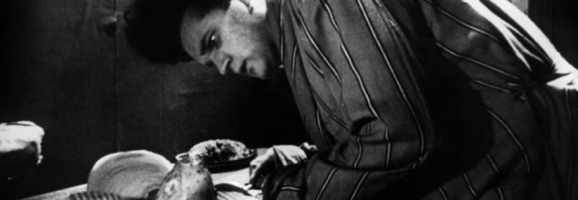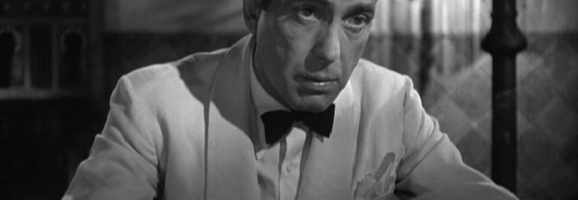The Vintage Aesthetic: The Function of Contemporary Black & White Cinema

With advances in technology propelling contemporary cinema towards high definition, higher frame rates, and 3D, it’s endearing to see that black and white films can still have a great amount of success. In 2013, Frances Ha, Nebraska, and A Field in England proved that cinema still has a place for black and white, even if it now has closer ties with art films than Hollywood. This raises an interesting question – why do some filmmakers still choose the black and white aesthetic and what effect does this have on their work?
Béla Tarr and Jim Jarmusch, have both made frequent use of black and white in their films. Having never been an avid fan of either, I cannot help but wonder if their almost unquestioned praise comes from their aesthetic decisions. I think a lot of cinephiles would admit to taking pleasure from the pastiche of the black and white aesthetic; part of the success of films like The Artist centres around this reference to Classical Hollywood. This suggests that black and white has close ties with postmodernism in its appeal.

This postmodern aspect is the key element in many of these films; particularly films like Pleasantville, Young Frankenstein, and Zelig, as their appeal is centred on their mimicry of Classical Hollywood. Noah Baumbach revealed that one of the main reasons he chose black and white for Frances Ha was that it brings a form of ‘instant nostalgia’ with it, suggesting something more than simple mimicry. I think this is key to a film like The Last Picture Show as it borrows a conventionally ‘old-school’ aesthetic to present a traditional American town collapsing under the weight of modernism. The fact that this has a direct effect on the cinema in the town also ties in with the film’s aesthetic, as it seems fitting to reference Classical Hollywood through the image of the film itself.
Black and white isn’t necessarily used to create feelings of nostalgia or to reference Classical Hollywood. It can also have a profound, otherworldly effect. Eraserhead and Pi are clear examples of this. They are both set in bizarre, black and white worlds, acting as visual representations of a protagonist’s troubled mind; this is also tied to feelings of confusion and the uncanny. Lynch makes use of this in The Elephant Man. Its black and white aesthetic is justified by the fact that it is set in the past but it also suggests something uncomfortable and extremely negative. As a disfigured man, John Merrick lives in a world surrounded by fear, a world where he is in constant danger. Black and white is a way of creating something insular and immersive in its otherworldliness, thus helping the audience to relate to Merrick’s point of view.

Themes of suppression and threat were later filtered through black and white by Michael Haneke in his bleak study of pre-war Germany – The White Ribbon. The film is set in a town plagued by a number of freak ‘accidents’, and there is a sense that many of the characters are unable to escape the control of the townspeople. It is difficult to even imagine many of these films in colour as their meaning is so heavily tied to their lack of this. It would be wrong to suggest that black and white only has negative connotations. Wim Wenders utilised the style in his tranquil masterpiece, Wings of Desire, as a way of presenting the heavenly world of the angel at the film’s core, perhaps inspired by the heaven sequences in A Matter of Life and Death. This is also an example of black and white being used to convey the world of a specific character, suggesting it often functions subjectively.
Many filmmakers are notable for using black and white in their early work. Christopher Nolan, for example, shot his debut films Doodlebug and Following in this style, as did Kevin Smith with Clerks. This student film aesthetic is possibly used less for practical purposes and more as a way of celebrating a stripped-back, low-budget type of filmmaking. There could also be a number of other reasons. Elements of nostalgia and references to Classical Hollywood seem to still be very much at the foundation of such decisions. Practical reasons is another plausible explanation. A famous example of black and white being used to solve a problem is in Psycho where Hitchcock successfully masked the fact he had used chocolate syrup instead of fake blood. This was not the only reason for his decision and the ‘B-movie’ look of the black and white film was also imperative to its creepiness at the time. It is possible that filmmakers working today have a similar mind-set when it comes to choosing whether or not the shoot in colour.

In the digital age changing from colour to black and white can be done with the flick of a switch and has little to no financial ties. Back in the 1990s many student filmmakers were still shooting on celluloid and thus had a bigger decision to make. When Lynch shot Eraserhead in the 1970s, for example, he was filming on a specific type of film stock and thus his decision to shoot in black and white would have to have been made during pre-production. Now, it is much more likely for a filmmaker to shoot an entire film in colour and then decide post-production to switch to black and white. Frank Darabont’s The Mist is even available in both colour and black and white, showing that the decision requires no real effort anymore.
To refer back to Eraserhead, it is important to note the relationship black and white cinema has with so-called ‘Midnight Movies’ and gritty, niche films. Some notable examples include French shocker Man Bites Dog and the crazy Japanese film Tetsuo: The Iron Man with its fetishistic focus on metal, superbly reflected through its black and white aesthetic. This link with grittiness is not just tied to midnight movies, La Haine also depicts an underground world of crime that is well-suited to a bleak, black and white image. This can all be related back to films like The Elephant Man and its suggestion of something negative through its lack of colour.

One final element that is key to contemporary black and white films ties in with technological advancement. High definition has given filmmakers options that simply weren’t available to those working in the Classical era. Béla Tarr’s work is particularly notable in relation to this. The Turin Horse and The Werckmeister Harmonies display such aesthetic beauty that they go above and beyond anything from the Classical Hollywood era. These films are literally black and white whereas Classical Hollywood is actually more of a grey colour, underscoring this as a limitation more than a choice. A Field in England displays a similar amount of aesthetic beauty, creating a whole new meaning for the black and white image. This has the potential to shake off any negative connotations tied to black and white (suggestions that it is old-fashioned and no longer needed) because high definition adds a sense of modernity to the image. Although, as briefly mentioned above, there is most definitely a lack of black and white in mainstream cinema, perhaps because of these well-known negative connotations.

Now that choice is a factor in the production of black and white films, they take on a whole new meaning. The homage to the Classical era is often plain to see, particularly as contemporary filmmakers attempt to capture something encapsulated within a lost era – could you imagine Citizen Kane, Casablanca, Rebecca, or any Film Noir in colour? As well as this, some choose to extend their films beyond the grey of Classical Hollywood and into a new era of glossy black and white that shines in high definition. I hope this style continues to be chosen by filmmakers. Ironically, it seems to be mainstream Hollywood that are the most likely to reject the use black and white but hopefully this will change in the near future.

Some other notable contemporary black and white films include: Ed Wood, Control, Sin City, The Man Who Wasn’t There, Manhattan, Killer of Sheep, Raging Bull, and Schindler’s List.
What do you think? Leave a comment.











Coffee and Cigarettes, and I know it’s not completely B&W, but Pleasantville. Both great!
I love black and white movies, especially when they throw in alittle red, its really appealing to me, Sin City is one of my favorite movies but hands down, Schindler’s List is a epic masterpiece that is in a league of its own. that little girl with the red dress was amazing, the story is true, and it tells time that humanity was real crude. I did not enjoy this movie until I hit my early 20s, it is simply too deep for the younger audience to understand.
Black and white conveys a very specific aesthetic. Before, it was used because it was cheaper, but today it is used to create a ‘vintage’ effect and convey nostalgia. When filmmakers and photographers use it, they consider the beauty of the lines and the play between light and shadow. The photo studio Harcourt is very famous for its treatment of black and white, and generations of stars went there to get a unique portrait.
Some DVDs propose both options, such as It’s a Wonderful life; you can either watch the original black and white version, or the remastered coloured version, and you can feel the difference.
This article also made me think of Memento, where scenes in colour alternate with black and white sequences. It allows Nolan to create confusion between past and present, and the audience has to reconstruct the storyline by taking into account the changes from colour to black and white. It’s brilliant!
I find watching the colour version of It’s A Wonderful life to be such a bizarre experience. It’s almost as if it’s been transferred to a completely different setting. I think this ties into my suggestion that it’s difficult to even imagine a lot of the classics in colour. I also agree with what you said about Memento, Nolan is so skilled at knowing when to use black and white.
Oh, gosh. The thought of watching It’s A Wonderful Life in color makes my skin crawl. Same with any of the classics I know in black and white.
As far as contemporary use of black and white, I like it when it doesn’t feel like the filmmaker is just trying to be artistic. A film like Frances Ha, for example, has its merits for being b&w — the lack of color allows a stronger focus on the character — but I don’t think making the film in color would have taken anything away from it. Something like The Artist, of course, had to be black and white. The aesthetic was essential.
Nice read. Thing to note is it costs more money to shoot on black and white film than in color. These are films made by true artists who understand the medium of film. Black and white is used to evoke a certain era, place, and emotional undercurrent. Sin City is probably the only movie that used HD video cameras instead of B&W film, and Rodriguez did it to portray the noir style of the comic graphic novel.
I deliberately omitted Sin City simply because it would probably require a whole article of its own. The use of colour and black & white in that film ties in so nicely with its stylised aesthetic.
I believe that the movie-Schinder’s List although already powerful in the sense that it touches on a heavy topic regarding the extraordinary courage of one man, would have been a lot different emotionally, if it was in color. The black and white allowed us to jump into a moment of history where it seemed all hope and color was lost. It created a thought-provoking atmosphere and allowed to feel as if were living in the era of World War II.
Black and White does in a way allow us to be nostalgic for the era of classic Hollywood, but is also a great method in telling a story or drawing on a powerful and effective response from the audience.
Good points all, but I do think it’s important to mention The French New Wave as an influence on the decision to use B&W. Specifically with a film like Frances Ha, which itself feels like such an homage to Truffaut.
I’ve heard it argued (specifically in a discussion about David Lynch) that B&W can also be used to have a sort of distancing or surreal effect on the audience. Obviously, your mileage may vary, but I was wondering if you had any thoughts on that? Is the choice to use color photography a choice for realism?
Then, if B&W does occupy a space outside of “real” cinema, is that due to it’s relationship to film as a whole? For instance, if the use of Black and White can create a relationship with the audience via genre (Film Noir, The “Midnight Movie,” etc.), does that relationship distance the audience from the film as being a “real” story about “real” characters?
I agree with your point about the French New Wave, although there are of course many that were filmed in colour, but the influence is surely there.
I think your suggestion that it links to the surreal is basically what I was trying to say with its ‘otherwordly effect’, especially in relation to Lynch.
It’s interesting that you talk about black and white distancing the audience as a number of my favourite films are shot in this way and I find it actually has the opposite effect on me 🙂 Although it does move away from a traditional conceptions of realism though, meaning these films have the potential to become more cinematic and aesthetically pleasing.
I actually appreciate some of the modern black and white film was mentioned in this article. I just replenished my Netflix Queue. Some movies I need to revisit, and some I’ve just never had a chance to see.
you know it’s a great movie when you don’t even realize it’s in black and white at some points. Ed wood, young frankenstein, clerks and schindlers list are among my favorites. Goodnight and good luck is’nt one of my favorites but is still stellar.
I saw Nebraska recently (great film by the way), and I couldn’t imagine it in anything but black and white. The B&W allows the audience to focus on story and characters, while giving the film a dampened, depressed look, which fit right in with the dreary setting of Montana and Nebraska during the winter and with the melancholic tone.
I’ve yet to see Frances Ha, but I’ve heard great things *u*.
This isn’t a conventional film but I saw that they had colorized all the old footage from the first nuclear tests, the footage that I had seen many times before suddenly seemed so much more real. As if before it was just abstract enough to deny, or at least not really comprehend the enormity of these blasts. I’m 32 and grew up watching color, so black and white always looks abstract or intentionally artistic to me but I never thought of the ways it could be used to help a film achieved its desired effect. Great article thanks –
Very nice write-up of the black & white aesthetic in recent films! It’s really interesting to see the recent uptake in B&W as a very tidy, high-contrast style (and you’re right, a whole article on Sin City is very much needed) whereas the classical Hollywood aesthetic that they hark back to is more shades of grey. I wonder, though, whether the recent interest in black and white cinematography is actually part of a larger trend towards a more monochromatic-like color aesthetic in contemporary cinema. Like when the sudden wave of neo-Westerns a few years ago was followed by an uptake of sepia in all sorts of movies, especially war films, or a lot of sci-fi TV and film resorting to the cool blue look for futuristic scenes. There’s definitely a lot to be said about contemporary cinema’s new found relationship with color (or lack thereof)…
Great article! One of my favorite films, Woody Allen’s Manhattan, uses black and white as an aesthetic choice and is absolutely gorgeous. Thanks for the read!
As a beginning film student, I have been watching quite a few black and white movies over the months. While I do love color films because that is what is familiar, watching movies like Francis Ha, Nebraska, and my favorite movie Notorious, they just seem so much more artistic and creative. Plus the use of shadows and the fact that using black and white makes an audience think vintage, the use of no color in black and white movies make them seem better, more classic.
I think it is interesting to consider the shift from the B&W Clerks to the full color Clerks 2. There is a massive shift in tone from color alone, although the two films were made with a big time gap between.
The first time I saw John Woo’s Face/Off, our DVD player was a little busted and only played the movie in black and white. After later seeing it in color, I really feel like I saw two entirely different films – the tone, the feel, and aesthetic were drastically changed. I’m not sure which I preferred, but the B&W version definitely felt more genuine and older. Odd connotations for such an absurd film.
I thought this was a great read—seems like B&W always tries to add a hint of nostalgia to the screen, whether it’s in The Artist or Sin City. Or if you look at a film like Aronofsky’s “π” you certainly spend more mental energy on the story as opposed to the images.
Zelig is an interesting choice of B&W Woody Allen movie to reference. It seems that in that film, Allen chooses B&W to create a world that feels historical. The B&W image seems like found and collected footage, an effect perhaps different than nostalgia. Manhattan, of course, seems like a movie that more insistently begs the question “Why black and white?”
This is a fantastic piece of work and has some really great comments on the usage of black and white in cinema. Also a great choice of films to reference.
I hate people who think B&W movies are garbage. It’s their loss. Anyone who is closed-minded enough to not watch B&W is missing out on some of the best movies ever made.
One of, if not my favorite use of black and white is Lars von Trier’s Antichrist. The prologue and epilogue in that crisp black and white with the deep contrast is absolutely beautiful. The chapters of Antichrist are colorless, just like Breaking the Waves, with the dark colors of the woods and the house. So the beginning and ending of the film stand out as so elegant, especially with the addition of the classical music involved, the black and white adds to this feeling. Although the context of the scenes are disturbing, the epilogue and prologue are the most memorable, mainly through the use of black and white. Also Woody Allen’s Manhattan is a wonderful example of black and white for narrative purposes, since the film starts off him saying how the city will always appear black and white to him, showing how classical and nostalgic, as the article stated and I strongly agree with, settings are and how settings are portrayed through black and white. Really great article!!
For me, Pi is one of the best examples of B&W’s role in cinema. Notice that Pi was actually shot on black-and-white reversal film, giving it a high-contrast aesthetic that is different from traditional black-and-white. With heightened contrast, the images are close to black OR white, with minimal gray in between.
Aranofsky, who is brilliant, did this intentionally and has referenced it numerous times. His goal here was to pull the viewer into Max’s perspective, characterized by heavy distortion and the polarizing certainty of mathematics. Such an aesthetic allows viewers to connect to the character when they would otherwise be unable, even if they are not consciously considering the artistic impetus.
Fascinating investigation of a growing phenomenon in film. I think you are right in asserting that the black-and-white aesthetic can emphasize key elements of certain films, yet I never fully considered just how various the effects of this technique could be. I grew up on the “classics,” so I always felt comfortable with the silver screen; although I always found that my generation was largely prejudiced against anything that didn’t come in color. The fact that black and white is becoming more accepted may speak to a deeper dissatisfaction with modern film-making techniques, which, in my opinion, rely too heavily on dazzling special effects rather than the artistry of film itself, which relies on a subtle manipulation of lighting, camera angles, music, and dialogue. I will be keeping tabs on this topic for sure!
I agree that black and white has been cast aside as a “nostalgic” mode of shooting. That’s a sad notion because in many respects black and white is superior to color in its ability to convey that otherworldly quality that you wrote about and in its ability to register subtleties in shape and light that color tends to overshadow. I think that the problem now is that black and white is a medium of abstraction in a culture that expects cinema to represent a visual reality as accurately as possible. No matter how ridiculous the scene, it has to look real. We must be convinced. Black and white inherently halts that reality, but the gain comes with the fact that we actually start to look at what we’re watching.
Some thoughts:
Black & White (still) or motion picture imagery allows the viewer to focus on the whole: that is, not focus on any one detail in a scene, but rather allows a full gulp, as it were, to better understand/feel the emotional impact the photographic artist or cinematographer is trying to capture. In regard to the negative connotations B&W might elicit, subject matter plays a pivotal role in how a viewer perceives a story (film) or interpretation of a Black & White photograph. B&W only instils a negative vibe if the content so demands. A great piece, Alice. Thank you.
Kind regards,
Lance A. Lewin
http://www.emotionalrenderings.com
You mentioned Lynch a lot which begs me to raise the question of how artists move between the two options. Beginning in black and white was the natural route for many film makers we now regard as masters and it is undoubted that it offers a much more considered education on lighting and colour. In black and white the emphasis is down to lighting to mix up your tones in the frame, when a film maker then moves to colour they are spolied for choice but with training in black and white are sure to much more carefully deploy different colours. Consider Blue Velvet as an example of an evocative, striking and down right excelled use of colour. It’s not just reality as we see it filmed as it was but carries much more significance which i think many filmmakers without a base in b&w overlook.